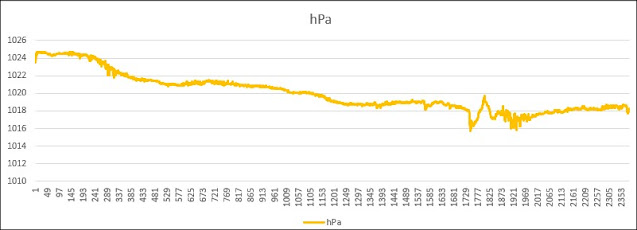Voyager 2.5 - 39 hours of Ocean Sailing Data
This article will summarize some the key real world statistics established after 39 hours at sea.
This information is only available because we are able to retrieve the vessel from rocks and read the on-board SD Card.
Voyager sailed well for about 39 hours until she stopped sailing due to water ingress.
Power Consumption
The Battery was a pack of 14 x 18650 Cells, made up as 7P x 2S.
One of the cells had been tested and verified as having better than 3000mAhr in the voltage range of 4.2Vdc down to 3.0Vdc.
The main battery dropped from 8.30V to 8.12V over the mission.
This corresponds to 0.18Vdc drop over 39hours, or 0.11Vdc drop per day
Assuming a constant rate voltage drop, this would yield 20 days expect life, allowing for a 2.2Vdc drop, from 8.3Vdc to 6.1Vdc .
The actual rate of voltage drop would increase as voltage drops.
The actual rate of voltage drop would increase as voltage drops.
The Voyage Controller employs switching regulators to drop the 2S voltage down to 5Vdc for the servo, and 3.3Vdc for the electronics. As the supply voltage drops, the supply current increases to maintain a constant power consumption.
The Wing Sail battery voltage dropped from 4.16V to 4.08V over the mission.
This corresponded to 0.08Vdc drop over 39hours, which is 0.05Vdc drop per day.
This yields 20 days expect life
The Battery consists of 2 x 3Ahr 18650 Cells x 1S
Steering Servo Usage
The steering servo made 67k movements over the mission in 39hours
This corresponds to 1.8k movements per hour.
The Wing Sail Trim Tab made 9,895 movements over the mission, 39hours.
This average out at 250 movements per hour over the mission.
The rate of movement was 10 movements per hours over the first 6 hours.
Pitch
The variation of Pitch over mission was not extreme. The largest value of pitch was 10 degrees, at the start, while on land. The next largest was 9 degrees down, but typical values were less than 4 degrees.
Roll
The variation of roll over mission was not extreme. The largest value of roll occurred on land. The next largest was 40 degrees, but generally under 20 degrees.
Temperature
The temperature is measured in Wing Angle Sensor located in the Wing Angle Senor housing located at the base of the mast.
The measured temperature varied in accordance with the diurnal cycle over the 39 hours of the voyage, except for the last half hour where the measured temperature increased dramatically.This was most likely due to water damage.
Atmospheric Pressure
The barometric pressure sensor is collocated with the compass sensor.
Link for plot of positions reported via satellite:









No comments:
Post a Comment